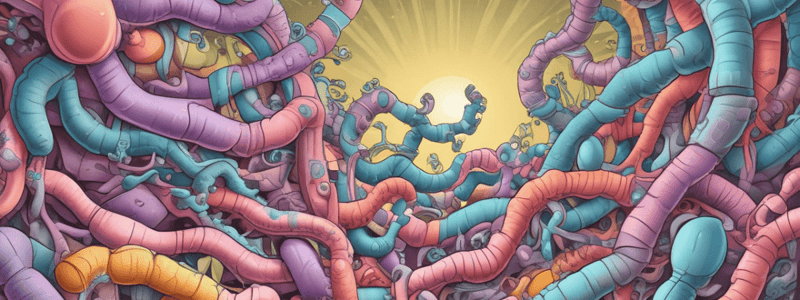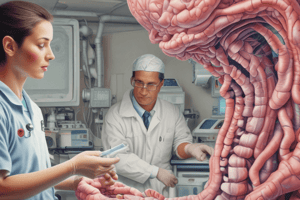Podcast
Questions and Answers
What is the primary indication for prescribing rifaximin?
What is the primary indication for prescribing rifaximin?
- Inflammatory bowel disease
- Sigmoid diverticulitis
- Hepatic encephalopathy (correct)
- Diverticular disease
Why are NSAIDs not recommended for the treatment of diverticular disease?
Why are NSAIDs not recommended for the treatment of diverticular disease?
- Due to their immunomodulatory activities
- Due to the risk of side effects, such as perforation or bleeding (correct)
- Due to their slow onset of action
- Due to their anti-inflammatory properties
What percentage of patients experience subsequent episodes of symptom recurrence and emergency management after an episode of complicated sigmoid diverticulitis?
What percentage of patients experience subsequent episodes of symptom recurrence and emergency management after an episode of complicated sigmoid diverticulitis?
- Approximately one-third (correct)
- Approximately two-thirds
- Approximately three-quarters
- Approximately one-quarter
What is the primary mechanism of action of mesalazine?
What is the primary mechanism of action of mesalazine?
What is the role of corticosteroids in the treatment of diverticular disease?
What is the role of corticosteroids in the treatment of diverticular disease?
What is the association between NSAIDs and paracetamol use, and tumor morbidity?
What is the association between NSAIDs and paracetamol use, and tumor morbidity?
What is the reported effectiveness of oral rifaximin as monotherapy for diverticular disease?
What is the reported effectiveness of oral rifaximin as monotherapy for diverticular disease?
What is the primary purpose of using mesalazine in treating diverticular disease?
What is the primary purpose of using mesalazine in treating diverticular disease?
What is the quality of evidence supporting the use of probiotics to treat or prevent diverticular disease manifestations?
What is the quality of evidence supporting the use of probiotics to treat or prevent diverticular disease manifestations?
Why is it not recommended to use CT as a commonly used imaging modality?
Why is it not recommended to use CT as a commonly used imaging modality?
What is the most common class of side effect seen with the use of UPAs?
What is the most common class of side effect seen with the use of UPAs?
What is the incidence of diarrhea among patients taking UPAs in phase 3 clinical trials?
What is the incidence of diarrhea among patients taking UPAs in phase 3 clinical trials?
What is the rate of diarrhea in UPA-treated patients with a known diagnosis of IBS?
What is the rate of diarrhea in UPA-treated patients with a known diagnosis of IBS?
What is the focus of large research projects in the field of symptoms in diverticular disease?
What is the focus of large research projects in the field of symptoms in diverticular disease?
What is not well understood about the colon-directed fiber treatment?
What is not well understood about the colon-directed fiber treatment?
What is a potential future direction for research in the field of diverticular disease?
What is a potential future direction for research in the field of diverticular disease?
What is the current status of discovering potential biomarkers and signaling pathways in the diverticulosis wall and mesenteric surrounding tissues?
What is the current status of discovering potential biomarkers and signaling pathways in the diverticulosis wall and mesenteric surrounding tissues?
What is a limitation of current studies on diverticular disease?
What is a limitation of current studies on diverticular disease?
What is the relationship between diverticulose and diverticulite?
What is the relationship between diverticulose and diverticulite?
Why is it challenging to develop effective treatment strategies for diverticular disease?
Why is it challenging to develop effective treatment strategies for diverticular disease?
How many studies have focused on the inflammatory status of the mesentery in the symptoms of diverticular disease?
How many studies have focused on the inflammatory status of the mesentery in the symptoms of diverticular disease?
What is the outcome of using pioglitazone or tumor necrosis factor α (TNFα) inhibitor in trials?
What is the outcome of using pioglitazone or tumor necrosis factor α (TNFα) inhibitor in trials?
What is the primary goal of using a controlled-release drug delivery system of hydrocortisone acetate in the treatment of recurrent acute diverticulitis?
What is the primary goal of using a controlled-release drug delivery system of hydrocortisone acetate in the treatment of recurrent acute diverticulitis?
What is the current limitation of using probiotics from the Bifidobacterium genus in the treatment of diverticular disease?
What is the current limitation of using probiotics from the Bifidobacterium genus in the treatment of diverticular disease?
What is the characteristic of a specific type of probiotic combination, namely Lactobacillus and Bifidobacterium?
What is the characteristic of a specific type of probiotic combination, namely Lactobacillus and Bifidobacterium?
What is the primary reason for focusing on the root cause of diverticular disease, which is intestinal inflammation?
What is the primary reason for focusing on the root cause of diverticular disease, which is intestinal inflammation?
What is the promising result of an open-label phase 2 trial on vedolizumab effectivity?
What is the promising result of an open-label phase 2 trial on vedolizumab effectivity?
What is the role of α-1β1 integrin-mediated DOCK-coupled regulation of Rac1 in diverticular disease?
What is the role of α-1β1 integrin-mediated DOCK-coupled regulation of Rac1 in diverticular disease?
What is the current limitation of using apl-2 as a treatment option for diverticular disease?
What is the current limitation of using apl-2 as a treatment option for diverticular disease?
What is the potential additional option to modulate the immune response in diverticular disease?
What is the potential additional option to modulate the immune response in diverticular disease?
What is the hypothesis regarding the role of SIRT1 signalling in diverticulitis?
What is the hypothesis regarding the role of SIRT1 signalling in diverticulitis?
What is the current limitation of using corticosteroid preparations for the local administration in diverticular disease?
What is the current limitation of using corticosteroid preparations for the local administration in diverticular disease?
Flashcards are hidden until you start studying
Study Notes
Anti-Inflammatory Agents
- NSAIDs are not recommended for the treatment of diverticular disease due to the risk of side effects, such as perforation or bleeding.
- Rifaximin, an alpha-pyrido, semisynthetic and non-absorbable antibiotic, is primarily prescribed for the treatment of hepatic encephalopathy, diarrheal syndrome, and inflammatory bowel disease.
- Mesalazine is an aminosalicylate drug with anti-inflammatory properties; it possesses anti-inflammatory, immunomodulatory, and antioxidant activities.
Corticosteroids
- Corticosteroids are used during acute diverticulitis because of their fast onset of action.
- The locoregional modulation of the immune-inflammatory response, through the rectal administration of low doses of corticosteroids using a controlled-release drug delivery system of hydrocortisone acetate, is a promising therapy for recurrent episodes of acute diverticulitis.
Probiotics in Diverticular Disease
- Probiotics are defined as “live microorganisms that when administered in adequate amounts confer a health-enhancing effect on the host.”
- A type of probiotic, namely a combination of Lactobacillus and Bifidobacterium, is characterized by its ability to reduce the proportion of Escherichia coli and Enterococci, restore the physiological proportion of α- and β-hemolytic Streptococci, and slightly affect the adhesion of intestinal epithelial cells.
Emerging Pharmacotherapies
- Vedolizumab has shown promising results in an open-label phase 2 trial and has begun an RCT phase 3.
- α-4β-7 integrin antagonist clenoliximab and oral small molecule α-4β-7 antagonists have shown a reduction of pro-inflammatory cytokines levels and may represent additional options to modulate the immune response.
- Apl-2 is promising as a treatment option for diverticular disease, preventing diverticulitis severe forms and diverticulosis progression.
Adverse Effects and Monitoring
- Gastrointestinal (GI) side effects are the most common class of side effect seen with the use of UPAs.
- The incidence of diarrhea ranged from 10% to 21% of patients taking UPAs, and the discontinuation rate due to diarrhea-related symptoms was 0.3% to 5% of patients.
Conclusion and Future Directions
- Large research projects in the field of symptoms in diverticular disease have mainly focused on the colon itself, and more research is needed to understand the pathophysiology of symptomatic diverticular disease and to find new treatment strategies to reduce symptom load and improve quality of life.
Studying That Suits You
Use AI to generate personalized quizzes and flashcards to suit your learning preferences.




